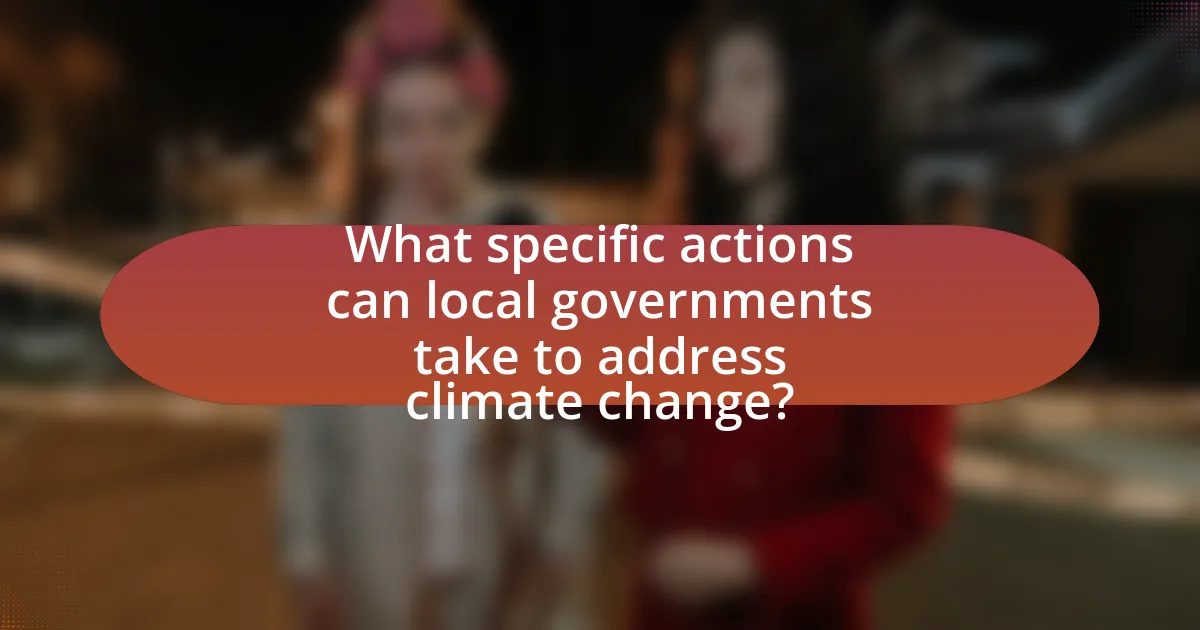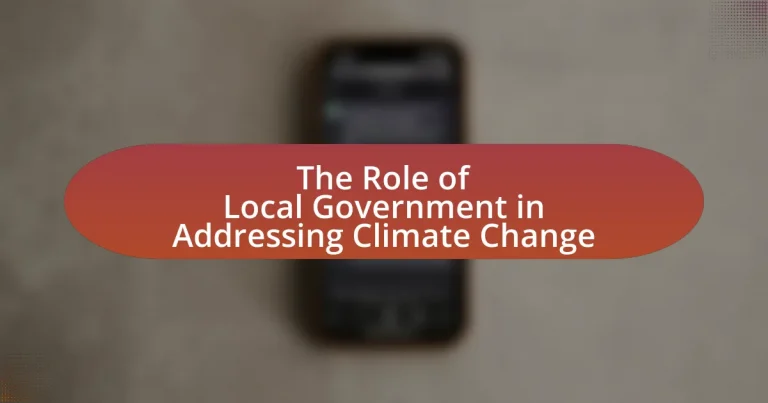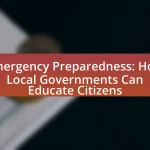Local governments play a vital role in addressing climate change through the implementation of policies and initiatives that promote sustainability and resilience. They are responsible for local land use planning, enforcing energy-efficient building codes, and engaging communities in climate adaptation strategies. The article explores how local governments influence climate change policies, the specific powers they hold, and the collaborative efforts they undertake with various entities. It also discusses the challenges they face, such as financial constraints and political dynamics, while highlighting best practices for effective climate action and community engagement. Overall, local governments are essential in mitigating climate change impacts and fostering community resilience through targeted actions and strategic partnerships.

What is the Role of Local Government in Addressing Climate Change?
Local governments play a crucial role in addressing climate change by implementing policies and initiatives that promote sustainability and resilience. They are responsible for local land use planning, which can prioritize green spaces and reduce urban sprawl, thereby lowering greenhouse gas emissions. Additionally, local governments can enforce building codes that require energy-efficient designs and renewable energy sources, contributing to reduced energy consumption.
For instance, according to the Global Covenant of Mayors for Climate and Energy, local governments can significantly impact emissions reduction by adopting climate action plans that align with international agreements like the Paris Agreement. Furthermore, local governments often engage communities in climate adaptation strategies, such as improving infrastructure to withstand extreme weather events, which is essential as climate change leads to more frequent and severe weather patterns.
In summary, local governments are pivotal in climate change mitigation and adaptation through policy-making, community engagement, and infrastructure development, supported by frameworks and initiatives that guide their actions.
How do local governments influence climate change policies?
Local governments influence climate change policies by implementing regulations, promoting sustainability initiatives, and engaging in community education. They create local ordinances that can limit greenhouse gas emissions, such as building codes that require energy-efficient designs. For example, cities like San Francisco have adopted strict emissions reduction targets, which directly impact local industries and residents. Additionally, local governments often collaborate with state and federal agencies to align their policies with broader climate goals, ensuring that local actions contribute to national and international climate commitments. This multi-level governance approach enhances the effectiveness of climate strategies and fosters community involvement in sustainability efforts.
What specific powers do local governments have in climate action?
Local governments possess specific powers in climate action, including the authority to implement zoning regulations, enforce building codes, and promote renewable energy initiatives. These powers enable local governments to shape land use and development patterns that support sustainability. For instance, cities can establish green building standards that require energy-efficient designs, thereby reducing greenhouse gas emissions. Additionally, local governments can create incentives for residents and businesses to adopt renewable energy sources, such as solar panels, which contributes to a decrease in reliance on fossil fuels. Furthermore, local governments often have the ability to develop and enforce local climate action plans, which outline strategies for reducing emissions and enhancing resilience to climate impacts. These actions are supported by legal frameworks that grant municipalities the autonomy to address environmental issues at the local level.
How do local governments collaborate with other entities on climate initiatives?
Local governments collaborate with other entities on climate initiatives through partnerships with non-profit organizations, private sector businesses, and regional or national agencies. These collaborations often involve joint projects aimed at reducing greenhouse gas emissions, enhancing sustainability practices, and promoting community resilience. For instance, the U.S. Conference of Mayors has reported that many cities engage in initiatives like the Climate Mayors network, which facilitates sharing best practices and resources among local governments. Additionally, local governments frequently apply for grants from federal programs, such as the Environmental Protection Agency’s Climate Change Adaptation Grant Program, to fund collaborative projects that address climate impacts.
Why is local government involvement crucial in climate change mitigation?
Local government involvement is crucial in climate change mitigation because it enables tailored, community-specific strategies that effectively address local environmental challenges. Local governments have the authority to implement policies, regulations, and initiatives that directly impact emissions reduction, such as promoting renewable energy, enhancing public transportation, and improving waste management. For instance, cities like San Francisco have successfully reduced greenhouse gas emissions by 36% since 1990 through local policies focused on sustainability and energy efficiency. This localized approach allows for greater public engagement and accountability, ensuring that climate actions are relevant and effective for the communities they serve.
What unique advantages do local governments have in addressing climate issues?
Local governments possess unique advantages in addressing climate issues due to their proximity to communities and ability to implement localized solutions. They can tailor climate policies to specific regional needs, leveraging local knowledge and resources. For instance, local governments can engage directly with residents to promote sustainable practices, such as recycling and energy efficiency, which can lead to higher participation rates compared to broader, national initiatives. Additionally, they often have more flexibility in funding and can access state and federal grants aimed at climate resilience projects. This localized approach enables quicker decision-making and implementation of initiatives, as seen in cities like San Francisco, which has successfully implemented comprehensive climate action plans that directly address local environmental challenges.
How does local governance impact community resilience to climate change?
Local governance significantly enhances community resilience to climate change by facilitating tailored adaptation strategies and resource allocation. Local governments can implement policies that address specific vulnerabilities within their communities, such as flood management systems or heat action plans, which are crucial in mitigating climate impacts. For instance, a study by the National Oceanic and Atmospheric Administration (NOAA) found that communities with proactive local governance structures were 30% more likely to implement effective climate adaptation measures compared to those without such frameworks. This demonstrates that local governance plays a critical role in fostering resilience through targeted interventions and community engagement.
What challenges do local governments face in combating climate change?
Local governments face significant challenges in combating climate change, primarily due to limited financial resources and competing priorities. Many local governments operate under tight budgets, which restrict their ability to invest in sustainable infrastructure and climate resilience projects. For instance, a report from the National League of Cities indicates that 70% of cities cite budget constraints as a major barrier to implementing climate initiatives. Additionally, local governments often struggle with a lack of technical expertise and data to effectively plan and execute climate action strategies. This is compounded by the need to balance climate goals with immediate community needs, such as housing and public safety, leading to further complications in prioritizing climate action.
What are the financial constraints local governments encounter?
Local governments encounter several financial constraints, primarily including limited revenue sources, budgetary restrictions, and rising costs associated with climate change initiatives. These entities often rely heavily on property taxes, sales taxes, and state or federal funding, which can fluctuate and may not keep pace with increasing demands for services and infrastructure improvements. For instance, a report from the National League of Cities indicates that nearly 60% of local governments face budget shortfalls, limiting their ability to invest in climate resilience projects. Additionally, the costs of implementing sustainable practices and adapting to climate impacts can strain already tight budgets, making it challenging for local governments to fulfill their roles effectively in addressing climate change.
How do political dynamics affect local climate initiatives?
Political dynamics significantly influence local climate initiatives by shaping policy priorities, funding availability, and community engagement. Local governments often align their climate strategies with the political ideologies of elected officials, which can either promote or hinder environmental actions. For instance, in regions where leadership prioritizes sustainability, initiatives such as renewable energy projects and emissions reduction programs are more likely to receive support and funding. Conversely, in areas where political leadership is skeptical of climate change, local initiatives may face budget cuts or lack of legislative backing, as seen in various U.S. states where climate action plans were rolled back following changes in administration. This relationship underscores the importance of political will in determining the effectiveness and scope of local climate initiatives.
How can local governments effectively implement climate action plans?
Local governments can effectively implement climate action plans by establishing clear goals, engaging the community, and securing funding. Clear goals provide a roadmap for action, while community engagement ensures that the plans reflect local needs and garner public support. For instance, the City of San Diego set a goal to achieve 100% renewable energy by 2035, which involved extensive community input and collaboration with stakeholders. Additionally, securing funding through grants and partnerships, such as those from the Federal Emergency Management Agency, can provide the necessary resources to execute these plans. These strategies demonstrate that local governments can successfully implement climate action plans by focusing on structured objectives, community involvement, and financial support.
What strategies can local governments adopt to engage the community in climate action?
Local governments can adopt strategies such as community workshops, educational campaigns, and participatory budgeting to engage the community in climate action. Community workshops facilitate direct dialogue between officials and residents, allowing for the exchange of ideas and concerns regarding climate initiatives. Educational campaigns raise awareness about climate change impacts and promote sustainable practices, evidenced by studies showing that informed communities are more likely to participate in climate actions. Participatory budgeting empowers residents to allocate funds for local climate projects, fostering a sense of ownership and responsibility, as demonstrated in cities like Paris, where such initiatives have led to increased public involvement in sustainability efforts.

What specific actions can local governments take to address climate change?
Local governments can implement specific actions to address climate change by adopting policies that promote renewable energy, enhance public transportation, and improve energy efficiency in buildings. For instance, local governments can establish incentives for solar panel installations, which can lead to a significant reduction in greenhouse gas emissions; a study by the National Renewable Energy Laboratory found that solar energy can reduce emissions by up to 90% in certain regions. Additionally, investing in public transportation systems can decrease reliance on personal vehicles, thereby lowering carbon footprints; cities like Portland have seen a 20% reduction in emissions due to improved transit options. Furthermore, enforcing building codes that require energy-efficient designs can lead to substantial energy savings; the U.S. Department of Energy reports that energy-efficient buildings can reduce energy consumption by 30-50%. These actions collectively contribute to mitigating climate change at the local level.
How can local governments promote sustainable transportation?
Local governments can promote sustainable transportation by implementing policies that encourage the use of public transit, cycling, and walking. For instance, cities can invest in expanding public transportation networks, which has been shown to reduce greenhouse gas emissions; a study by the American Public Transportation Association found that public transit use saves 45 million metric tons of carbon dioxide annually. Additionally, local governments can create dedicated bike lanes and pedestrian pathways, making these modes of transport safer and more appealing. Research indicates that cities with extensive bike infrastructure see a significant increase in cycling rates, contributing to lower traffic congestion and improved air quality. Furthermore, local governments can incentivize electric vehicle use through charging station installations and subsidies, aligning with the goal of reducing reliance on fossil fuels.
What policies can be enacted to encourage public transit use?
To encourage public transit use, local governments can implement policies such as subsidizing fares, enhancing service frequency, and investing in infrastructure improvements. Subsidizing fares can make public transit more affordable, as evidenced by a study from the American Public Transportation Association, which found that fare reductions can increase ridership by up to 20%. Enhancing service frequency reduces wait times, making transit more convenient; cities like New York have seen increased ridership with more frequent service. Additionally, investing in infrastructure, such as dedicated bus lanes and improved transit stations, can significantly enhance the user experience and attract more riders, as demonstrated by successful initiatives in cities like Los Angeles.
How can local governments support cycling and walking infrastructure?
Local governments can support cycling and walking infrastructure by investing in dedicated bike lanes, pedestrian pathways, and safe crossings. These investments enhance safety and accessibility, encouraging more residents to choose cycling and walking over driving. For instance, cities that have implemented extensive bike lane networks, such as Copenhagen, have seen a significant increase in cycling rates, with over 62% of residents using bicycles for daily commutes. Additionally, local governments can promote public awareness campaigns about the benefits of cycling and walking, further fostering a culture of active transportation.
What role do local governments play in energy efficiency and renewable energy?
Local governments play a crucial role in promoting energy efficiency and renewable energy by implementing policies, regulations, and programs that encourage sustainable practices. They often establish building codes that mandate energy-efficient designs, provide incentives for renewable energy installations, and facilitate community education on energy conservation. For instance, according to the U.S. Department of Energy, local governments can significantly influence energy consumption patterns through initiatives like energy audits and efficiency retrofits, which can lead to reductions in greenhouse gas emissions and lower energy costs for residents.
What incentives can local governments provide for renewable energy adoption?
Local governments can provide financial incentives such as tax credits, rebates, and grants to encourage renewable energy adoption. For instance, many municipalities offer property tax exemptions for solar energy installations, which can significantly reduce the upfront costs for homeowners and businesses. Additionally, local governments may implement feed-in tariffs that guarantee a fixed payment for energy produced from renewable sources, thus ensuring a stable income for producers. These incentives have been shown to increase the installation of renewable energy systems; for example, a study by the National Renewable Energy Laboratory found that states with robust incentive programs saw a 50% increase in solar installations compared to those without such programs.
How can local governments improve energy efficiency in public buildings?
Local governments can improve energy efficiency in public buildings by implementing energy audits and retrofitting existing structures with energy-efficient technologies. Energy audits identify areas where energy consumption can be reduced, while retrofitting can include upgrading insulation, installing energy-efficient lighting, and utilizing smart building technologies. According to the U.S. Department of Energy, buildings account for approximately 40% of total energy consumption in the United States, highlighting the significant impact that energy efficiency improvements can have on overall energy use and greenhouse gas emissions. By prioritizing these strategies, local governments can lead by example in reducing energy consumption and mitigating climate change.
How can local governments enhance waste management practices?
Local governments can enhance waste management practices by implementing comprehensive recycling programs and promoting waste reduction initiatives. These programs can significantly decrease landfill waste; for instance, cities like San Francisco have achieved a diversion rate of over 80% through mandatory recycling and composting laws. Additionally, local governments can invest in education campaigns to inform residents about proper waste disposal and the benefits of reducing single-use plastics, which contribute to environmental degradation. By adopting these strategies, local governments not only improve waste management but also contribute to broader climate change mitigation efforts.
What programs can be implemented to reduce waste at the community level?
Community-level waste reduction can be effectively achieved through programs such as recycling initiatives, composting programs, and waste reduction education campaigns. Recycling initiatives encourage residents to separate recyclable materials, which can significantly decrease landfill waste; for instance, communities that implement curbside recycling programs have reported recycling rates as high as 30% to 50%. Composting programs allow organic waste to be transformed into nutrient-rich soil, reducing the volume of waste sent to landfills and promoting sustainable gardening practices. Education campaigns raise awareness about waste reduction strategies, leading to behavioral changes that can further minimize waste generation. According to the Environmental Protection Agency, effective community education can lead to a 20% reduction in waste generation over time.
How can local governments promote recycling and composting initiatives?
Local governments can promote recycling and composting initiatives by implementing educational programs and providing accessible facilities. Educational programs raise awareness about the benefits of recycling and composting, leading to increased participation; for example, a study by the Environmental Protection Agency found that communities with educational outreach saw a 20% increase in recycling rates. Additionally, local governments can establish convenient drop-off centers and curbside collection services, making it easier for residents to recycle and compost. Research from the National Recycling Coalition indicates that communities with accessible recycling services can achieve recycling rates of over 50%.

What are the best practices for local governments in climate change initiatives?
Local governments should implement comprehensive climate action plans as a best practice for climate change initiatives. These plans should include measurable goals, community engagement, and integration of climate considerations into all local policies. For instance, the City of San Francisco’s Climate Action Strategy outlines specific targets for reducing greenhouse gas emissions and includes community input, demonstrating effective local governance in climate initiatives. Additionally, local governments can adopt renewable energy sources, enhance public transportation, and promote energy efficiency programs, as seen in cities like Portland, which has committed to 100% renewable energy by 2035. These practices not only mitigate climate impacts but also foster community resilience and economic growth.
How can local governments measure the effectiveness of their climate actions?
Local governments can measure the effectiveness of their climate actions by utilizing specific metrics such as greenhouse gas emissions reductions, energy consumption data, and community engagement levels. For instance, tracking changes in carbon emissions through annual inventories allows local governments to assess the impact of their policies and initiatives. Additionally, monitoring energy usage in municipal buildings and public transportation can provide insights into the effectiveness of energy efficiency programs. Engaging the community through surveys and feedback mechanisms can also help gauge public awareness and support for climate initiatives, further indicating their effectiveness.
What metrics should be used to evaluate climate action success?
To evaluate climate action success, key metrics include greenhouse gas emissions reductions, renewable energy adoption rates, and improvements in energy efficiency. Greenhouse gas emissions reductions are critical as they directly measure the effectiveness of climate policies; for instance, the Global Carbon Project reported a 7% decrease in emissions in 2020 due to pandemic-related restrictions, highlighting the impact of policy changes. Renewable energy adoption rates indicate the transition to sustainable energy sources; according to the International Renewable Energy Agency, global renewable energy capacity increased by 10.3% in 2020, showcasing progress in this area. Improvements in energy efficiency can be assessed through metrics like energy consumption per capita, which reflects how effectively energy is used in relation to economic output. These metrics collectively provide a comprehensive framework for assessing the success of climate actions undertaken by local governments.
How can local governments adjust strategies based on evaluation results?
Local governments can adjust strategies based on evaluation results by analyzing data from previous initiatives to identify effective practices and areas needing improvement. For instance, if an evaluation reveals that a specific waste management program significantly reduced landfill contributions, local governments can expand that program or allocate more resources to similar initiatives. Conversely, if a renewable energy project underperformed, governments can reassess its implementation, seek community feedback, and modify the approach to better align with local needs and conditions. This data-driven decision-making process is supported by studies showing that evidence-based adjustments lead to more successful climate action outcomes, as seen in the 2020 report by the International Council for Local Environmental Initiatives, which highlights the importance of continuous evaluation in enhancing local climate strategies.
What resources are available for local governments to enhance their climate strategies?
Local governments can enhance their climate strategies through various resources, including federal grants, technical assistance programs, and partnerships with non-profit organizations. For instance, the U.S. Environmental Protection Agency (EPA) offers funding opportunities such as the Climate Pollution Reduction Grants, which provide financial support for local climate initiatives. Additionally, organizations like ICLEI – Local Governments for Sustainability offer tools and resources for climate action planning, enabling municipalities to develop and implement effective strategies. These resources are crucial for local governments to address climate change effectively and meet their sustainability goals.
How can local governments access funding for climate initiatives?
Local governments can access funding for climate initiatives through various sources, including federal grants, state funding programs, and partnerships with private organizations. For instance, the U.S. Environmental Protection Agency (EPA) offers grants specifically for climate resilience and sustainability projects, which local governments can apply for to support their initiatives. Additionally, state governments often have dedicated funds for climate action, such as California’s Climate Investments program, which allocates cap-and-trade revenue to local projects. Furthermore, local governments can collaborate with non-profits and private sector entities to leverage additional resources and expertise, enhancing their ability to implement effective climate initiatives.
What partnerships can local governments form to strengthen their climate efforts?
Local governments can form partnerships with non-profit organizations, businesses, and academic institutions to strengthen their climate efforts. Collaborating with non-profits can enhance community engagement and provide resources for sustainability initiatives, while partnerships with businesses can lead to innovative solutions and funding for green projects. Additionally, working with academic institutions allows local governments to access research and expertise in climate science, enabling data-driven decision-making. For instance, the City of San Diego partnered with the University of California, San Diego, to develop a climate action plan that incorporates scientific research and community input, demonstrating the effectiveness of such collaborations in achieving climate goals.
What practical steps can local governments take to engage citizens in climate action?
Local governments can engage citizens in climate action by implementing community-based programs that promote sustainability and environmental awareness. These programs can include organizing local workshops on energy conservation, establishing community gardens, and facilitating neighborhood clean-up events. For instance, a study by the Urban Sustainability Directors Network found that cities that actively involve residents in sustainability initiatives see a 20% increase in community participation in climate-related activities. Additionally, local governments can create platforms for citizen feedback on climate policies, ensuring that community voices are heard and integrated into decision-making processes. This participatory approach not only fosters a sense of ownership among citizens but also enhances the effectiveness of climate action strategies.




